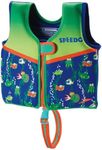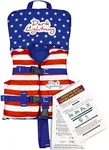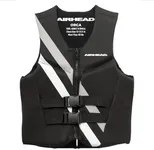Buying Guide for the Best Infant Life Vests
Choosing the right infant life vest is crucial for ensuring the safety of your child while they are in or around water. The right life vest will provide buoyancy, keep your child afloat, and ensure their head stays above water. When selecting an infant life vest, it's important to consider several key specifications to ensure it meets safety standards and fits your child's needs. Here are the key specs to look for and how to choose the best one for your infant.Buoyancy RatingBuoyancy rating indicates how much weight the life vest can support in the water. This is important because it ensures the vest can keep your child afloat. Infant life vests typically have a buoyancy rating of 7-15 pounds. For infants, you should look for a vest with a higher buoyancy rating within this range to provide extra support and safety.
Fit and SizeThe fit and size of the life vest are crucial for safety and comfort. A properly fitting vest will stay securely on your child and not ride up over their face. Infant life vests are usually designed for children weighing up to 30 pounds. Make sure to check the weight range specified by the manufacturer and choose a vest that fits snugly but comfortably on your child. Adjustable straps can help achieve a better fit.
Head SupportHead support is a feature that helps keep your infant's head above water, which is essential for preventing drowning. Look for a life vest with a padded headrest or collar that provides adequate support. This is especially important for younger infants who may not have strong neck muscles yet. Ensure the head support is comfortable and does not restrict movement.
Material and ConstructionThe material and construction of the life vest affect its durability and comfort. Most infant life vests are made from durable, water-resistant materials like nylon or polyester with foam padding for buoyancy. Check for high-quality stitching and secure closures like zippers and buckles. A well-constructed vest will last longer and provide better safety.
Safety CertificationsSafety certifications indicate that the life vest meets certain safety standards. Look for vests that are approved by organizations such as the U.S. Coast Guard (USCG) or Transport Canada. These certifications ensure the vest has been tested for safety and performance. Always choose a certified life vest to ensure it provides reliable protection.
VisibilityVisibility is an important safety feature, especially in emergency situations. Brightly colored vests or those with reflective strips make it easier to spot your child in the water. Choose a life vest with high-visibility colors like neon yellow, orange, or red to ensure your child can be easily seen.
Comfort FeaturesComfort features such as soft padding, breathable materials, and adjustable straps can make a life vest more comfortable for your child to wear. A comfortable vest is more likely to be worn correctly and consistently. Look for vests with features that enhance comfort without compromising safety.



















